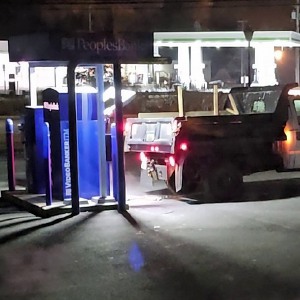Tree wreckers causing havoc: Spongy moth, emerald ash borer killing off oak and ash populations in area towns
|
Published: 04-01-2024 5:05 PM
Modified: 04-01-2024 5:17 PM |
GRANBY — The trees along the roadsides in Granby keep disappearing.
Resident Cheryl Funk first noticed the phenomena during daily trips past West Street Cemetery, where trees that had long greeted mourners were suddenly gone. Then she realized the tree belt on Burnett Street looked thinner than usual. When Funk couldn’t find the stumps of her favorite pair of century-old trees on Hubbard Drive, she began to raise concerns on Facebook about increased logging activity in town.
“I was kind of in shock because I don’t know that many old trees in Granby,” the 30-year resident said. “It broke my heart when I saw those two trees gone.”
Funk’s hunch is correct. Granby has cut at least 1,600 trees along the roadsides in the past three years, according to Tree Warden David Desrosiers. Each tree was declared dead, sick or hazardous to the roads.
Granby is one of many central and western Massachusetts towns aggressively logging large numbers of ash, birch, oak and maple species along roads. In 2022, Belchertown cut 117 trees along its roads and estimated another 387 require removal. In Hampden County, the town of Hampden has removed over 1,000 trees on the eastern side of town in the last five years.
Tree wardens and Department of Public Works executives from Granby, Hampden and Belchertown all give the same reason that so many trees are coming down — invasive insects, specifically the spongy moth (formerly known as the gypsy moth) and emerald ash borer. With these destructive, uncontrolled critters repeatedly defoliating trees throughout the area, local tree wardens have authorized the extraction of large numbers of dead and weakening trees that potentially could fall on streets, electric lines, cars, houses or people.
Spongy moths are non-native insects whose name comes from the spongy sacks of eggs the moths leave on trees. During their caterpillar stage, they devour leaves, mostly on deciduous trees, and in particular oaks. When trees lose their young leaves, they produce less food and must regrow their leaves, an energy-expensive process, without the same access to food.
The last outbreak of spongy moth caterpillars between 2015 and 2017 ravaged oak trees in eastern Hampshire, Hampden and Franklin counties, especially white oaks. In the summer of 2016, the caterpillars munched through nearly 353,000 acres, nine times as much acreage as 2015, according to state aerial surveys. Towns in Hampden County were hit hard.
Article continues after...
Yesterday's Most Read Articles
 The Iron Horse rides again: The storied Northampton club will reopen at last, May 15
The Iron Horse rides again: The storied Northampton club will reopen at last, May 15
 Homeless camp in Northampton ordered to disperse
Homeless camp in Northampton ordered to disperse
 Authorities ID victim in Greenfield slaying
Authorities ID victim in Greenfield slaying
 $100,000 theft: Granby Police seek help in ID’ing 3 who used dump truck to steal cash from ATM
$100,000 theft: Granby Police seek help in ID’ing 3 who used dump truck to steal cash from ATM
 UMass football: Spring Game closes one chapter for Minutemen, 2024 season fast approaching
UMass football: Spring Game closes one chapter for Minutemen, 2024 season fast approaching
 Final pick for Amherst regional superintendent, from Virgin Islands, aims to ‘lead with love’
Final pick for Amherst regional superintendent, from Virgin Islands, aims to ‘lead with love’
“We could see we’re gonna have an enormous problem,” Hampden’s Tree Warden Dana Pixley said. “They defoliated many of the trees in the first year. A lot of those trees are resilient. They come back, but if they get defoliated two or three years in a row, they die.”
The spongy moths came to Hampden from the east and found refuge from the eastern town line to Main Street. Pixley said the pests took a toll on the oak trees before moving onto other species. The damage was not only extensive, but costly: Hampden needed an extra $300,000 to remove all the dead and sick trees.
“We were spending three times the amount of money we normally would have spent,” said Pixley, who normally spends $50,000 a year on tree maintenance.
Hampden finished removing the trees hurt and killed by spongy moth caterpillars this year, but other towns hit a bit later by the insect outbreak, like Granby and Belchertown, are still mitigating the damage while managing emerald ash borer. These jewel-toned beetles lay eggs under the bark of ash trees, allowing larvas to eat the bark from the underside. During dry seasons, drought can further weaken the tree’s defenses. A wet season will allow water to penetrate areas of gouged bark, creating rot.
“Ash trees don’t stand very long. Once they die, the wood gets very bad very fast and they fall within a year,” Desrosiers said. “The oaks stand a little longer, so it’s a little easier to salvage some of the wood.”
UMass Extension experts who confirmed the presence of emerald ash borer advised Desrosier that the town of Granby should remove every ash tree in town, one of two common ways to control the disease. The other method is through a poison treatment, but Desrosier said this approach is not right for Granby because of the danger it poses to wells and septic systems.
Belchertown, on the other hand, uses these treatments to save certain American elm trees in the Town Common. Department of Public Works Superintendent Linda Leduc said the town uses a tree database to identify trees that require removal or treatments. An arborist comes every couple years to assess trees’ health, tag trees for removal or trim tree limbs.
“I feel lucky that we’re able to [treat trees] because our Town Common is very majestic and has some beautiful stately trees, and I know losing those elms in particular would be such a loss,” Leduc said.
The Belchertown DPW removes a few hundred trees a year based on the database information. Desrosier and Pixley can identify the dead trees themselves based on damage to the tree.
But Funk spent time looking at each of the trees marked for removal and isn’t convinced that disease is as prevalent in Granby as Desrosier says. She said that normally a tree warden must get Town Meeting approval to cut any public shade trees along the tree belt, except when a tree is sick or dead. Funk said none of these trees have been discussed at Town Meeting.
Desrosier said that’s because the trees pose a danger to the public.
“Many of the trees we have taken along the roadsides fall into the public shade tree regulations, but if the tree is dead, it has to be removed,” he said. “By law, we have to maintain the roads that are safe to travel and we have to remove any threats to the roadway, regardless if it’s a public shade tree.”
These invasive pests wreaked havoc among trees all over Granby, not just along the roadsides. Spongy moth caterpillars and woolly adelgid — an insect native to Asia that attacks North American hemlocks — lunched on many of the oak and hemlock trees in Dufresne Park, defoliating the trees several years in a row and eventually killing them.
Unlike spongy moths and emerald ash borer, woolly adelgids suck out the sap from hemlock needles, damaging the needles, twigs and branches. These critters can spread with strong winds, making them especially hard to treat.
“The literature suggests that you can spray for the adelgid if you have a favorite hemlock tree in your yard, but in the woods, the best way to deal with adelgid is to get your affected trees out, take out most of your overstory (the uppermost layer of foliage in a forest) and try to save some of the best-looking trees,” forester John Edwards said.
A consulting forester from Hadley with 40 years of experience in both public and private forests, Edwards began inspecting Dufresne’s trees in 2021 and immediately noticed the amount of standing dead oaks and maples, as well as sick and dying hemlock trees. These trees’ proximity to the trails posed a potential hazard to the park’s visitors.
“If you walk the trail of Dufrense Park, trees that I’ve marked two years ago that were standing have now fallen to the ground because they rotted out,” Edwards said. “They go from majestic cohorts to a danger to the town because that have open space and trails there.”
Edwards marked 1,674 trees across 30 of Dufresne Park’s 200 acres that had either died or remained very weak from repeated defoliations by caterpillars. According to the forest cutting plan that Edwards submitted to the Department of Conservation and Recreation, the mix of tree species scheduled for logging include red oak, white oak, black oak, white ash, white pine, and hemlock. The money from selling the timber will go into a fund for improvements and projects in Dufresne Park.
“There’s enough young oak and pine to justify overstory removal, salvage what could be salvaged, and remove the oak that probably would die,” Edwards said.
The DCR approved the cutting plan in 2022 and Kennebec Lumber Co, from Maine bid on the project for $71,000 soon after, but the actual logging started much later than originally planned. Edwards advised the town during a Select Board meeting in 2021 to wait until the ground froze over to remove any trees because freezing conditions lowers invasive pest activity and prevent weak trees from collapsing.
However, rainier and warmer winters never provided frozen conditions, giving trees two years to continue decomposing and collapsing. Granby Town Administrator Christopher Martin decided that the project could not be delayed further because “more and more trees kept coming down.”
“This is good forest management,” Martin said. “You’re suppose to take down the big trees so small trees can grow.”
This particular cutting plan is only phase one of a two-phase forestry cutting plan. Edward identified many more sick and dead hemlock trees are on a main trail next to a part of the park where Frisbee is played, and the thin soil will make it difficult for trees to recover.
“It’s very clear from my professional opinion that the trees that are still trying to persist there are going to die. They are probably better taken out and to try and change the cover there from a hardwood cover to a white pine cover,” Edwards said.
Martin wants to hold off on moving forward. With the amount of backlash and negative feedback from the first phase, Martin said he’s thinking of calling off phase two of logging. But Granby residents see the damage as already done.
“[The Select Board is] giving the OK to just clear-cut everywhere and it’s so sad to see it all happening,” said resident Nina Renshaw-Powers.
Emilee Klein can be reached at eklein@gazettenet.com.












 Authorities ID victim in Greenfield slaying
Authorities ID victim in Greenfield slaying  Federal probe targets UMass response to anti-Arab incidents
Federal probe targets UMass response to anti-Arab incidents Locking up carbon for good: Easthampton inventor’s CO2 removal system turns biomass into biochar
Locking up carbon for good: Easthampton inventor’s CO2 removal system turns biomass into biochar William Strickland, a longtime civil rights activist, scholar and friend of Malcolm X, has died
William Strickland, a longtime civil rights activist, scholar and friend of Malcolm X, has died
